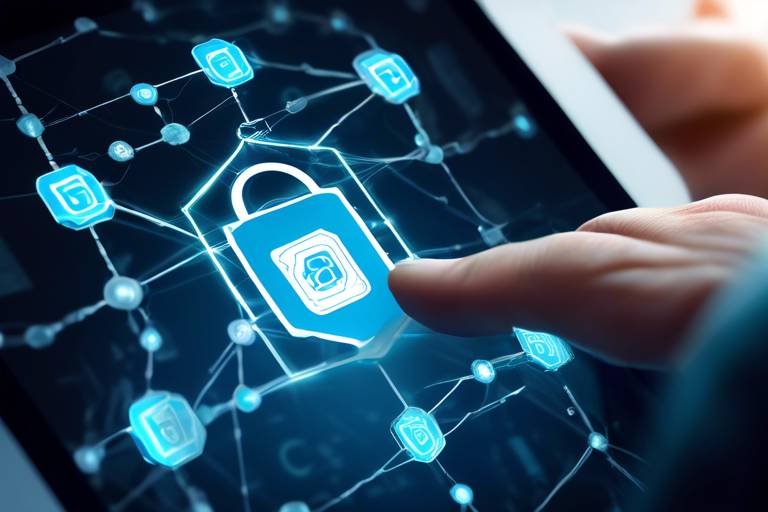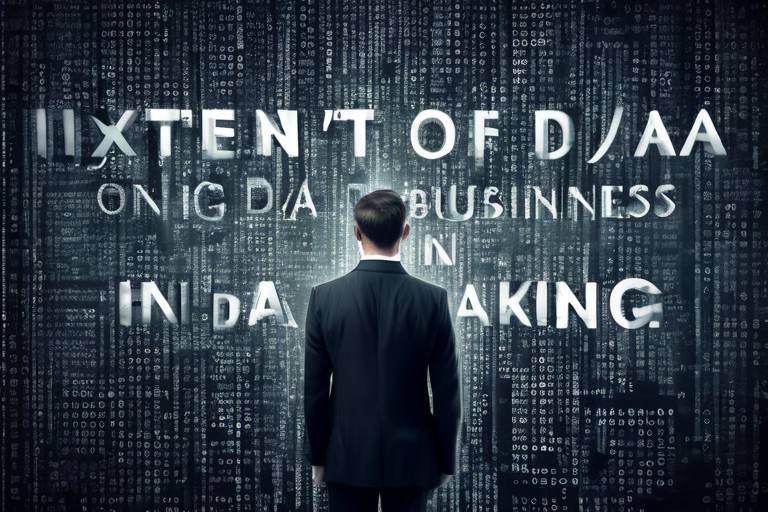Blockchain for Digital Identity: Securing Personal Data
In a world where our lives are increasingly lived online, the concept of digital identity has never been more critical. Think about it: every time you log into a social media account, make an online purchase, or even access your bank, you are relying on a digital representation of yourself. This identity is not just a username and password; it encompasses your personal data, financial information, and even your social interactions. As we dive deeper into the digital age, the need for secure and private management of this information becomes paramount. Enter blockchain technology, a revolutionary approach that promises to transform how we handle our digital identities.
Blockchain offers a unique solution to the challenges posed by traditional identity management systems. By leveraging a decentralized network, it eliminates the need for a central authority, which often becomes a single point of failure. Imagine a world where you have complete control over your personal data, where you can choose what to share and with whom, without the fear of it being misused or stolen. This is the promise of blockchain for digital identity, and it’s not just a pipe dream; it’s becoming a reality.
As we explore the intricacies of blockchain technology, we will uncover how it enhances digital identity management, ensuring that our personal data remains secure in an ever-evolving digital landscape. From decentralization to immutable records, blockchain offers a plethora of benefits that can significantly improve the way we manage our identities online.
Digital identity is not just a buzzword; it’s a fundamental aspect of our online existence. In today’s interconnected world, your digital identity affects not only how you interact with others but also how you access essential services. It plays a crucial role in various sectors, including finance, healthcare, and social networking. With the rise of data breaches and identity theft, the protection of our digital identities has become a pressing concern. Just think about how often you hear about companies losing customer data; it’s alarming! Therefore, ensuring the security and privacy of our digital identities is not just important—it’s essential.
At its core, blockchain is a decentralized ledger technology that records transactions across a network of computers. This means that instead of relying on a central server, the data is distributed across multiple nodes, making it incredibly difficult for hackers to alter or steal information. Each transaction is secured through cryptographic methods, ensuring that the data remains intact and confidential. Understanding how blockchain functions is crucial to appreciating its potential in transforming digital identity management.
One of the most significant advantages of blockchain is its decentralization. By removing intermediaries, users gain more control over their personal data. This shift not only enhances privacy but also drastically reduces the risk of data breaches. For instance, in a traditional system, if a centralized database is compromised, all user data is at risk. However, with blockchain, even if one node is attacked, the rest of the network remains secure. This is a game-changer in the realm of digital identity.
Blockchain employs advanced cryptographic techniques to secure data against unauthorized access. Every piece of information is encrypted, and only those with the correct keys can access it. This ensures that personal information remains confidential and protected from cyber threats. Imagine locking your personal diary with a state-of-the-art lock that only you can open—that’s the level of security blockchain offers for your digital identity.
Another remarkable feature of blockchain is its immutability. Once data is recorded on a blockchain, it cannot be altered or deleted. This creates a reliable and tamper-proof source of truth for digital identities. Think of it like a permanent record in a library; once a book is published, it remains unchanged. This characteristic not only fosters trust but also ensures accountability, making it difficult for malicious actors to manipulate information.
With blockchain technology, users can manage their identities without relying on centralized authorities. This empowerment fosters trust and encourages responsible data sharing. Imagine being able to verify your identity without having to provide sensitive information every time you sign up for a service. With blockchain, you can share only the necessary data, minimizing the risk of exposure. This new paradigm not only enhances user experience but also builds a more secure digital ecosystem.
Despite the numerous advantages of adopting blockchain for digital identity, there are significant hurdles to overcome. These challenges include regulatory compliance, technological barriers, and public awareness. Addressing these issues is crucial for the widespread implementation of blockchain solutions.
Navigating the complex landscape of data protection regulations is essential for integrating blockchain solutions into existing frameworks. Regulations vary widely across regions, and finding a balance between innovation and compliance can be tricky. It’s vital to ensure that users' rights are respected while leveraging the benefits of blockchain technology.
Current blockchain technologies face scalability and interoperability issues that hinder their effectiveness in managing digital identities on a large scale. For instance, as more users join a blockchain network, the system can become sluggish, leading to delays in transactions. Addressing these challenges is vital for future success and widespread adoption.
- What is blockchain technology?
Blockchain is a decentralized ledger technology that records transactions across multiple computers, ensuring security and transparency.
- How does blockchain enhance digital identity?
It allows users to control their personal data without relying on centralized authorities, enhancing privacy and security.
- What are the challenges of using blockchain for digital identity?
Challenges include regulatory compliance, technological limitations, and the need for public awareness.

The Importance of Digital Identity
This article explores how blockchain technology can enhance digital identity management, ensuring secure and private handling of personal data in an increasingly digital world.
In today’s hyper-connected world, digital identity is not just a buzzword; it’s the very essence of how we interact online. Think about it: your digital identity encompasses everything from your social media profiles to your online banking accounts. It’s like your online fingerprint, unique to you and crucial for accessing services, verifying your identity, and protecting your privacy. The stakes are high, and the implications of mishandling this identity can lead to severe consequences, ranging from identity theft to loss of access to essential services.
As we navigate this digital landscape, the importance of safeguarding our digital identities cannot be overstated. Here are a few reasons why:
- Security: A compromised digital identity can lead to unauthorized transactions and data breaches, which not only affect individuals but can also have ripple effects on businesses.
- Privacy: With increasing surveillance and data collection, maintaining control over your personal information is more important than ever.
- Access: Many services require a verified digital identity for access, whether it’s online banking, healthcare, or even social networking.
Moreover, the way we define and manage our digital identities is evolving. As technology advances, so do the methods of verification and authentication. Traditional methods, such as passwords and security questions, are becoming less reliable in the face of sophisticated cyber threats. This is where blockchain technology steps in, offering a revolutionary approach to digital identity management.
In essence, our digital identities serve as gateways to the online world. They hold the power to unlock opportunities or shut doors, depending on how well they are protected. The ability to control and secure our digital identities is paramount, especially as we move towards a future that increasingly relies on digital interactions. Blockchain technology promises to transform this landscape by providing a secure, decentralized method of managing identities, thus ensuring that our personal data remains safe and sound.
Blockchain is a decentralized ledger technology that ensures data integrity and security through cryptographic methods. Understanding its mechanics is essential to appreciate its application in digital identity management.
Decentralization eliminates the need for intermediaries, granting users more control over their personal data. This shift can significantly enhance privacy and reduce the risk of data breaches.
Blockchain employs advanced cryptographic techniques that secure data against unauthorized access, ensuring that personal information remains confidential and protected from cyber threats.
Once recorded on a blockchain, data cannot be altered or deleted, providing a reliable and tamper-proof source of truth for digital identities.
With blockchain, users can manage their identities without relying on centralized authorities. This empowerment fosters trust and encourages responsible data sharing.
Despite its advantages, the adoption of blockchain for digital identity faces hurdles such as regulatory compliance, technological barriers, and public awareness that must be addressed for widespread implementation.
Navigating the complex landscape of data protection regulations is essential for integrating blockchain solutions into existing frameworks without infringing on users' rights.
Current blockchain technologies face scalability and interoperability issues that hinder their effectiveness in managing digital identities on a large scale. Addressing these challenges is vital for future success.
What is a digital identity?
A digital identity is the online representation of an individual, encompassing various attributes such as usernames, passwords, and personal information used to access services.
How does blockchain enhance digital identity security?
Blockchain enhances security by providing a decentralized and tamper-proof method for storing personal information, making it less vulnerable to hacks and unauthorized access.
What are the main challenges to implementing blockchain for digital identity?
The main challenges include regulatory compliance, technological limitations, and the need for public awareness about the benefits of blockchain technology.

How Blockchain Works
Blockchain technology is often described as a decentralized ledger, but what does that really mean? At its core, blockchain is a system that records transactions across many computers, ensuring that the recorded data is secure, transparent, and immutable. Imagine a digital notebook that everyone can see but no one can erase or alter. Each page of this notebook represents a block, and as new transactions occur, new blocks are added, forming a chain—hence the name "blockchain."
To understand how blockchain enhances digital identity management, it’s essential to break down its key components:
- Decentralization: Unlike traditional databases controlled by a single entity, blockchain operates on a network of computers (or nodes) that share the same information. This means no single point of failure; if one computer goes down, the rest continue to function.
- Cryptographic Security: Each transaction is secured using cryptographic techniques, which involve complex mathematical algorithms. This ensures that only authorized users can access or modify their data, keeping personal information safe from prying eyes.
- Consensus Mechanisms: Before a new block is added to the blockchain, the network must agree that the transaction is valid. This is achieved through consensus mechanisms, such as Proof of Work or Proof of Stake, which help prevent fraud and ensure data integrity.
- Transparency: Every transaction is recorded on the blockchain and is visible to all participants in the network. This transparency builds trust, as everyone can verify the authenticity of the information.
Now, let’s delve deeper into some of the key features that make blockchain particularly suitable for digital identity management:
The decentralization aspect of blockchain technology is revolutionary. By removing intermediaries, users gain greater control over their personal data. Think of it like owning your own home instead of renting it. When you own your data, you decide who can access it and under what conditions. This shift not only enhances privacy but also significantly reduces the risk of data breaches, which are all too common with centralized systems.
Blockchain employs advanced cryptographic techniques that provide a robust layer of security. Each piece of data is encrypted, and only individuals with the correct cryptographic keys can access it. This means that even if a hacker were to gain access to the network, they would find it nearly impossible to decipher the encrypted data without the proper keys. In essence, blockchain acts as a digital fortress for your personal information.
One of the standout features of blockchain is its immutability. Once a transaction is recorded on the blockchain, it cannot be altered or deleted. This creates a reliable and tamper-proof source of truth for digital identities. Imagine trying to erase a permanent marker from a whiteboard—it's simply not possible! This characteristic ensures that users can trust the integrity of their digital identities, knowing that their information is securely stored and accurately represented.
With blockchain, users are no longer at the mercy of centralized authorities to manage their identities. They can take charge of their personal information, deciding what to share and with whom. This empowerment not only fosters trust among users but also encourages responsible data sharing. It’s akin to having a personal vault for your valuables—only you hold the key, and you decide who gets to see what's inside.
In summary, understanding how blockchain works is crucial for appreciating its potential in enhancing digital identity management. By leveraging decentralization, cryptographic security, and immutability, blockchain technology offers a promising solution to the challenges of securing personal data in our increasingly digital world.
1. What is blockchain technology?
Blockchain is a decentralized digital ledger that records transactions across a network of computers, ensuring data integrity and security through cryptographic methods.
2. How does blockchain enhance digital identity management?
Blockchain provides users with greater control over their personal data, enhances security through encryption, and ensures that records are immutable and transparent.
3. What are some challenges in implementing blockchain for digital identity?
Challenges include regulatory compliance, technological limitations such as scalability and interoperability, and the need for increased public awareness and education.

Decentralization Benefits
Imagine a world where you have complete control over your personal data, where you decide who accesses your information and when. This is the promise of decentralization in blockchain technology. By eliminating the need for intermediaries, such as banks or social media platforms, blockchain empowers individuals to manage their identities directly. This shift not only enhances user privacy but also significantly reduces the risk of data breaches, which are all too common in centralized systems.
With traditional identity management systems, your personal data is often stored in a single location, making it a prime target for hackers. In contrast, blockchain distributes data across a network of computers, ensuring that there is no single point of failure. This means that even if one node is compromised, the rest of the network remains secure. The decentralized nature of blockchain acts as a fortress, safeguarding your information against unauthorized access.
Furthermore, decentralization fosters a sense of trust among users. When individuals are in control of their own data, they are more likely to share it responsibly. This leads to a healthier ecosystem where data sharing is consensual and transparent. In a way, it’s like having a personal vault for your identity, where you hold the keys and can decide who gets to peek inside.
Here are some key benefits of decentralization in digital identity management:
- Enhanced Privacy: Users can choose what information to share and with whom, minimizing unnecessary exposure.
- Reduced Risk of Data Breaches: With data spread across multiple nodes, the chances of a successful attack diminish significantly.
- Greater Control: Users have the power to manage their digital identities without relying on third parties.
- Increased Trust: Transparent processes foster trust between users and service providers.
In summary, decentralization is not just a buzzword; it represents a fundamental shift in how we think about and manage our digital identities. By leveraging blockchain technology, we can create a more secure, private, and user-centric approach to identity management. The future is bright for those who embrace decentralization, as it paves the way for a more empowered and secure digital landscape.
- What is blockchain technology? Blockchain is a decentralized digital ledger that records transactions across multiple computers, ensuring security and data integrity.
- How does decentralization improve privacy? By removing intermediaries, users have direct control over their data, allowing them to decide what to share and with whom.
- What are the risks associated with centralized identity systems? Centralized systems are more vulnerable to data breaches, as they store information in a single location, making them attractive targets for hackers.
- Can blockchain help in regulatory compliance? Yes, blockchain can enhance transparency and traceability, which can assist organizations in meeting regulatory requirements.

Enhanced Security Features
When we talk about in blockchain technology, it’s like discussing a superhero’s armor—designed to protect and defend against all sorts of threats. Blockchain employs a range of advanced cryptographic techniques that act like a digital fortress around your personal data. Imagine your sensitive information, such as your name, address, and financial details, locked away in a high-security vault that only you have the key to. This is precisely what blockchain aims to achieve.
One of the standout features of blockchain is its use of public and private keys. Each user has a unique pair of keys that work together to secure their data. The public key is like your home address; it’s visible to everyone and allows others to send you information. On the other hand, the private key is akin to your home’s front door key—only you should have access to it. This ensures that even if someone knows your address, they can’t enter your home without the key. Such a system drastically minimizes the risk of unauthorized access to personal information.
Moreover, blockchain’s decentralized nature means that there’s no single point of failure. Traditional systems often store data in a central location, making them prime targets for hackers. In contrast, blockchain distributes data across a network of computers, making it incredibly difficult for cybercriminals to breach. Think of it as spreading your valuables across multiple safes instead of keeping them all in one. If one safe is compromised, the others remain secure, thereby enhancing the overall security of your data.
Additionally, the concept of immutable records plays a crucial role in bolstering security. Once information is entered into a blockchain, it cannot be altered or deleted. This immutability acts as a safeguard against fraud and tampering, providing a reliable and tamper-proof source of truth for digital identities. It’s like having a permanent record of your identity that cannot be rewritten, ensuring that your digital footprint remains intact and trustworthy.
In summary, the enhanced security features of blockchain technology provide a robust framework for protecting personal data. By utilizing cryptographic techniques, decentralized storage, and immutable records, blockchain not only secures individual identities but also fosters a sense of trust and safety in the digital world. As we continue to navigate an increasingly online society, these features will become essential in safeguarding our most sensitive information.
- What is blockchain technology?
Blockchain is a decentralized digital ledger that records transactions across multiple computers, ensuring that the recorded data is secure, transparent, and tamper-proof. - How does blockchain enhance security for digital identities?
Blockchain enhances security through cryptographic techniques, decentralized data storage, and immutable records, making it difficult for unauthorized users to access or alter personal information. - What are public and private keys?
Public keys are like your address that others can see, while private keys are your personal keys that allow you to access and manage your data securely. - Can blockchain be hacked?
While no system is completely immune to hacking, the decentralized nature of blockchain makes it significantly more challenging for hackers to compromise compared to traditional centralized systems.

Immutable Records
When we talk about in the context of blockchain, we're diving into one of the most revolutionary aspects of this technology. Imagine a diary that, once written in, cannot be edited or erased. This is essentially what blockchain offers for digital identities. Each entry—be it your name, date of birth, or any other personal information—is recorded in a way that is permanent and unchangeable. This means that once your data is on the blockchain, it becomes a reliable and tamper-proof source of truth.
The significance of immutability cannot be overstated. In a world where data breaches and identity theft are rampant, having a secure method of storing personal information is like having a fortress around your most valuable assets. With traditional databases, records can be modified or deleted, often leading to discrepancies and potential fraud. However, with blockchain, any attempt to alter the information would be immediately evident, as every change is recorded and visible to all participants in the network.
This immutability is achieved through a process called hashing. Each block in the blockchain contains a unique hash of its contents, along with the hash of the previous block. This creates a chain of blocks that are interconnected. If someone tries to change a record, the hash would change, breaking the chain and alerting the network to the tampering attempt. In this way, blockchain acts as a guardian of your digital identity, ensuring that your information remains intact and trustworthy.
Moreover, the immutability of records fosters a new level of trust among users and service providers. When you know that your data cannot be altered without your consent, you are more likely to share it with confidence. The transparency offered by blockchain allows individuals to verify the authenticity of their information, which is especially crucial in sectors like finance, healthcare, and education. Imagine applying for a job and being able to present an unalterable record of your qualifications and work history. It’s a game-changer!
In summary, the concept of immutable records is a cornerstone of blockchain technology that significantly enhances the security and reliability of digital identities. By ensuring that your personal data remains unchanged and protected, blockchain not only safeguards your information but also empowers you as a user, allowing you to take control of your digital identity like never before.
- What does it mean for a record to be immutable?
An immutable record cannot be changed or deleted once it has been created, providing a permanent and trustworthy source of information. - How does blockchain ensure immutability?
Through a process called hashing, where each block contains a unique identifier that links it to the previous block, making any alteration detectable. - Why is immutability important for digital identity?
It prevents unauthorized changes and enhances trust among users and service providers, making it crucial for protecting personal data.

User Empowerment
In the realm of digital identity, is a game-changer. Imagine a world where you, and only you, control your personal information. Sounds liberating, right? That's precisely what blockchain technology offers. By decentralizing the management of digital identities, blockchain removes the reliance on traditional intermediaries like banks or social media platforms. This shift not only enhances your control but also places the power back into your hands. You decide who sees your data, how it's used, and when it's shared.
Think of it like owning a safe deposit box. Instead of a bank holding your valuables, you keep them securely under your control. With blockchain, you can store your digital identity in a virtual vault, accessible only to you. This means you can share your information selectively, ensuring that it reaches only those who need it, whether it's a service provider requiring your ID or a healthcare professional needing your medical history.
Moreover, the empowerment extends beyond mere control. It fosters trust in the digital ecosystem. When users know they have the autonomy to manage their identities, they're more likely to engage in responsible data sharing. This trust is crucial in a world where data breaches and privacy violations are rampant. By participating in a blockchain-based identity system, users can feel confident that their information is secure and that they have a say in how it's utilized.
However, it's essential to recognize that with great power comes great responsibility. Users must be informed and educated about how to navigate this new landscape. Understanding the implications of sharing data, recognizing potential risks, and knowing how to safeguard personal information are vital skills in this digital age. As blockchain technology continues to evolve, the emphasis on user empowerment will likely lead to a more informed and conscientious user base.
In summary, the concept of user empowerment through blockchain technology is not just about control; it's about creating a more equitable digital landscape. As we move forward, the challenge will be to ensure that everyone has access to the tools and knowledge necessary to harness this power effectively.
- What is user empowerment in the context of blockchain? User empowerment refers to the ability of individuals to control their own digital identities without relying on centralized authorities.
- How does blockchain enhance security for personal data? Blockchain uses cryptographic techniques to secure data, making it resistant to unauthorized access and cyber threats.
- What are the risks associated with managing my own digital identity? Users must be aware of potential risks, such as sharing too much information or falling prey to scams, and should educate themselves on best practices for data security.
- Can I still use traditional services while managing my identity on blockchain? Yes, blockchain can complement traditional services, offering an additional layer of security and control over your personal data.

Challenges in Implementation
Despite the promising potential of blockchain technology in enhancing digital identity management, several challenges hinder its widespread adoption. Firstly, there are regulatory concerns that must be navigated. Governments and regulatory bodies around the world are still grappling with how to classify and manage blockchain technology within existing legal frameworks. This is particularly important in the context of data protection laws, such as the General Data Protection Regulation (GDPR) in Europe. The decentralized nature of blockchain can complicate compliance, as it raises questions about user rights, data ownership, and the ability to erase personal data when requested. Without clear regulations, organizations may hesitate to implement blockchain solutions, fearing legal repercussions.
Secondly, technological limitations pose another significant barrier. Current blockchain systems often struggle with scalability and interoperability. Scalability refers to the capacity of the blockchain to handle a growing amount of work, or its ability to accommodate an increasing number of transactions without compromising speed or efficiency. For example, Bitcoin and Ethereum, two of the most well-known blockchains, face challenges when it comes to processing large volumes of transactions quickly. This can be a major drawback for applications that require real-time processing, such as digital identity verification.
Moreover, interoperability is critical for the seamless integration of blockchain with existing systems and other blockchain networks. Currently, many blockchain platforms operate in silos, making it difficult for them to communicate with one another. This lack of interoperability can lead to fragmented digital identity ecosystems, where users may have to manage multiple identities across different platforms. To overcome these challenges, developers must focus on creating solutions that not only enhance scalability but also ensure that various blockchain systems can work together effectively.
Additionally, public awareness and understanding of blockchain technology remain limited. Many users are still unfamiliar with how blockchain works and the benefits it can offer for digital identity management. This lack of knowledge can result in skepticism and reluctance to adopt new technologies. For blockchain to gain traction, educational initiatives that inform users about its advantages, particularly in terms of security and privacy, are essential. Only when users feel confident in their understanding of blockchain will they be more likely to embrace it as a solution for managing their digital identities.
In conclusion, while blockchain technology holds immense promise for improving digital identity management, addressing these challenges is crucial for its successful implementation. Regulatory compliance, technological limitations, and public awareness must all be tackled to ensure that blockchain can truly revolutionize the way we handle personal data in our increasingly digital world.
- What is blockchain technology?
Blockchain is a decentralized digital ledger that records transactions across multiple computers in a way that the registered transactions cannot be altered retroactively. - How does blockchain enhance digital identity?
Blockchain enhances digital identity by providing a secure, tamper-proof way to manage personal data, giving users greater control over their information. - What are the main challenges of implementing blockchain for digital identity?
The main challenges include regulatory compliance, technological limitations, and a lack of public awareness and understanding of the technology.

Regulatory Concerns
When it comes to implementing blockchain technology for digital identity management, one of the most significant hurdles is navigating the complex landscape of regulatory compliance. Governments and regulatory bodies worldwide are still grappling with how to handle the implications of blockchain, which can create uncertainty for both users and service providers. The decentralized nature of blockchain presents unique challenges, as traditional regulatory frameworks are often designed for centralized systems.
For instance, consider the General Data Protection Regulation (GDPR) in Europe, which mandates strict rules on how personal data is collected, stored, and processed. With blockchain's immutable records, once data is recorded, it cannot be altered or deleted. This characteristic poses a dilemma: how can organizations comply with regulations that require the right to erasure while utilizing a technology that inherently resists data modification? This paradox can lead to potential legal conflicts, making it crucial for stakeholders to engage with regulators to find workable solutions.
Furthermore, the global nature of blockchain technology means that different countries may have varying regulations regarding data privacy and protection. This inconsistency can create a complicated web of compliance requirements for businesses operating internationally. To illustrate this point, let's take a look at a simplified comparison of regulatory approaches in different regions:
| Region | Key Regulations | Compliance Challenges |
|---|---|---|
| Europe | GDPR | Right to erasure vs. immutability |
| United States | CCPA | Varying state laws |
| Asia | PDPA (Singapore) | Data localization requirements |
As we can see, the regulatory landscape is not only fragmented but also evolving. This ongoing evolution necessitates continuous dialogue between blockchain developers, businesses, and regulators to create frameworks that can effectively integrate blockchain technology while protecting user rights. Public awareness also plays a critical role in this equation. As individuals become more informed about their rights and the implications of their digital identities, they will demand greater transparency and accountability from both service providers and regulators.
Ultimately, addressing these regulatory concerns is not just a matter of compliance; it’s about building a framework that fosters trust in blockchain technology as a viable solution for digital identity management. Only through collaboration can we hope to create a secure and private environment for personal data in this digital age.
- What is blockchain technology? Blockchain is a decentralized digital ledger that records transactions across multiple computers, ensuring data integrity and security.
- How does blockchain enhance digital identity management? It provides users with greater control over their personal data, enhances security through cryptographic techniques, and creates immutable records.
- What are the main regulatory challenges faced by blockchain? The main challenges include compliance with data protection regulations, navigating varying international laws, and addressing the paradox of data immutability versus the right to erasure.

Technological Limitations
While blockchain technology holds immense promise for enhancing digital identity management, it is not without its . These challenges can hinder the widespread adoption of blockchain solutions, making it crucial to understand them in order to pave the way for future advancements. One of the most pressing issues is scalability. Current blockchain networks often struggle to handle large volumes of transactions efficiently. For instance, Bitcoin can process only about seven transactions per second, while Ethereum manages around 30. In contrast, traditional payment systems like Visa can handle thousands of transactions in the same timeframe. This stark difference raises concerns about the feasibility of using blockchain for real-time identity verification in high-traffic scenarios.
Another significant hurdle is interoperability. Different blockchain platforms often operate in silos, lacking the ability to communicate with one another. This fragmentation can create challenges when trying to integrate multiple blockchain solutions into a cohesive identity management system. Imagine trying to connect various social media accounts, each with its own unique login requirements. If these platforms were built on different blockchains, users would face a cumbersome process of managing multiple identities, which defeats the purpose of a streamlined digital identity.
Moreover, the energy consumption associated with some blockchain networks is a growing concern. The proof-of-work mechanism used by many popular blockchains requires substantial computational power, leading to environmental issues. As society becomes increasingly conscious of its carbon footprint, the energy-intensive nature of these systems could deter organizations from adopting blockchain for identity management. It’s like trying to power a small village with a single solar panel; it simply won’t meet the demand.
Finally, there’s the challenge of user education. Many individuals and organizations still lack a deep understanding of blockchain technology. This knowledge gap can lead to skepticism and reluctance to adopt blockchain solutions for digital identity management. If users don’t understand how their data is secured or how to use these systems effectively, they may shy away from what could be a revolutionary change in the way we handle personal information.
In summary, while blockchain technology offers transformative potential for digital identity management, addressing these is vital. Overcoming scalability and interoperability issues, reducing energy consumption, and enhancing user education will be key to unlocking the full benefits of blockchain in this crucial area.
- What is blockchain technology?
Blockchain is a decentralized ledger technology that securely records transactions across many computers, ensuring that the data cannot be altered retroactively.
- How does blockchain enhance digital identity?
Blockchain enhances digital identity by providing a secure, tamper-proof method of storing and managing personal information, giving users more control over their data.
- What are the main challenges of using blockchain for digital identity?
The main challenges include scalability, interoperability, energy consumption, and the need for user education.
- Can blockchain prevent data breaches?
While blockchain can significantly reduce the risk of data breaches through its secure architecture, no system is entirely immune to cyber threats.
Frequently Asked Questions
- What is digital identity, and why is it important?
Digital identity refers to the online representation of an individual, encompassing personal information, credentials, and online behaviors. In today's digital world, it plays a crucial role in accessing services, ensuring security, and protecting privacy. A robust digital identity is essential because it safeguards your personal data and enables you to navigate the online landscape safely.
- How does blockchain enhance digital identity management?
Blockchain technology improves digital identity management by providing a decentralized platform that secures personal data through cryptographic methods. This means that users have more control over their information, reducing the risk of data breaches and unauthorized access. With its immutable records, blockchain ensures that once data is recorded, it cannot be altered or deleted, providing a reliable source of truth.
- What are the benefits of decentralization in digital identity?
Decentralization eliminates the need for intermediaries, giving users direct control over their personal data. This shift enhances privacy and security, as individuals can manage their identities without relying on centralized authorities that often expose them to risks. It fosters trust and encourages responsible sharing of information.
- What challenges does blockchain face in digital identity implementation?
Despite its advantages, implementing blockchain for digital identity comes with challenges such as regulatory compliance, technological limitations, and public awareness. Navigating complex data protection regulations is crucial to ensure that blockchain solutions integrate smoothly into existing frameworks without infringing on users' rights.
- What are the technological limitations of blockchain for digital identity?
Current blockchain technologies face scalability and interoperability issues, which can hinder their effectiveness in managing digital identities on a large scale. Addressing these challenges is vital for achieving widespread adoption and ensuring that blockchain can meet the demands of a growing digital landscape.
- How can users ensure their digital identity is secure?
Users can enhance the security of their digital identities by utilizing blockchain technology, which offers advanced cryptographic features to protect personal information. Additionally, practicing good online habits, such as using strong passwords, enabling two-factor authentication, and being cautious about sharing personal data, can further safeguard against potential threats.


















